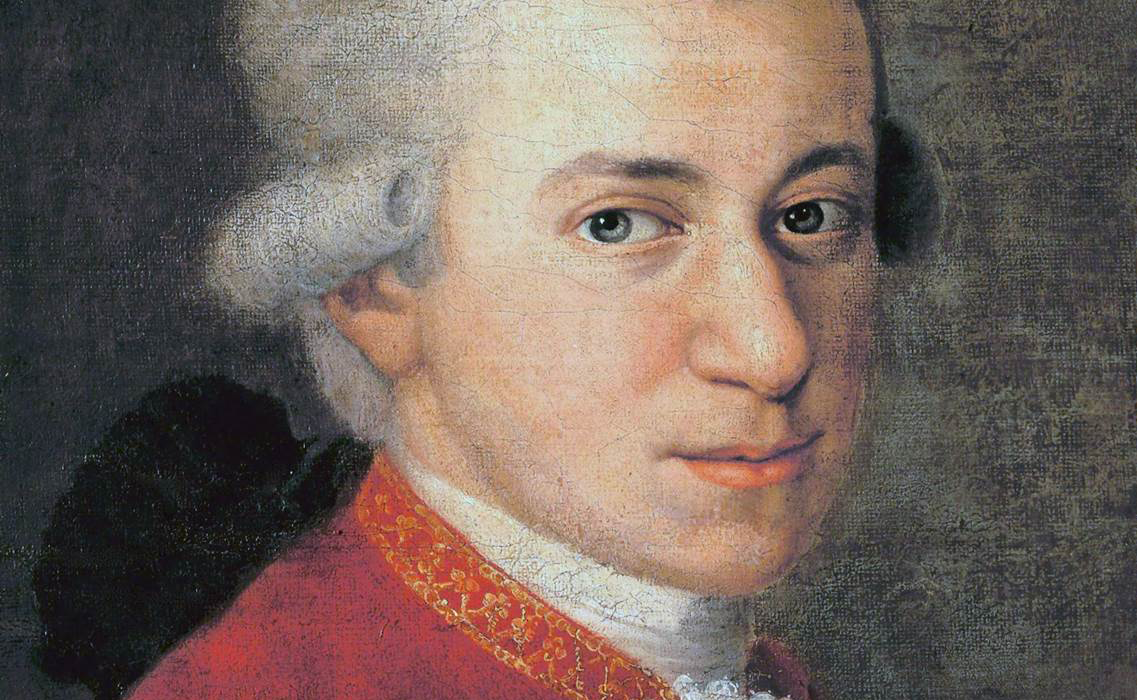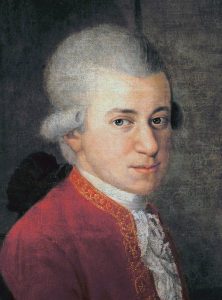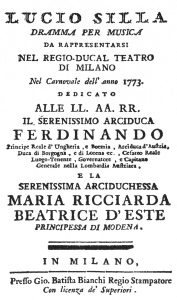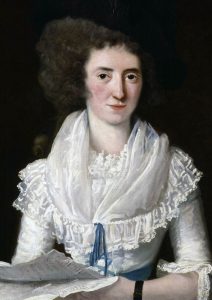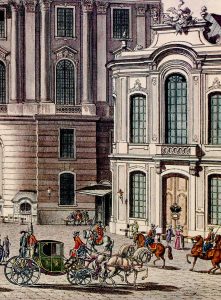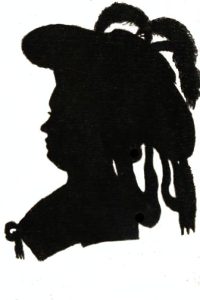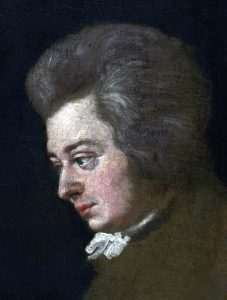Mozart and opera
Every time the idea comes to mind that it would be good to write an opera, I feel as if my body was afire, and tremble from head to foot with impatience.
Wolfgang Amadeus Mozart,
Letter of July 31, 1778
Of the two main styles of opera in Italian that dominated the 18th-century stage, opera seria (serious opera) was the most prestigous. Its complex plots were drawn from mythology or ancient history. Its libretti described conflicts between love and duty, fidelity and treason. Its rather static sequences of recitativo secco (with basso continuo accompaniment) advanced the action, while in its arias the characters expressed their passions and bared their souls. Outside of Italy, this was the type of opera favored by the aristocracy and ruling dynasties. The second type, opera buffa (comic opera), featured naive bumpkins, cunning or knavish servants, and pretentious bourgeois as, in lively and ‘natural’ settings, they became embroiled in various tangled love affairs and ludicrously unlikely ploys, disguises, shams, and misunderstandings.
From an early age Mozart was fascinated by the stage—as early as 1764, Leopold wrote that his 8-year old son “now always has an opera in his head”—and was keen to represent in music the full range of human emotions, from the noblest to the most farcical. He began composing works for the stage at the earliest possible opportunity. According to Brigitte Massin, “opera in its long evolutionary path, kept the composer busy during practically the entirety of his life, from when, in London, he first expressed interest in the form, during all the years of his childhood, and right up until he wrote The Magic Flute at the end of his life.” By absorbing the works for stage of his Italian or Italianized predecessors, as well as the art of their vocalists, he developed a profound understanding of bel canto singing. And while still quite young he constructed sumptuous orchestrations—the Germans had recently surpassed the Italians in handling the orchestra, giving ever greater importance to the often exposed winds.
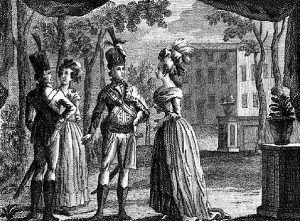
Scene from La finta semplice
In 1768, Leopold planned to have his son compose an opera buffa to celebrate the marriage of an imperial princess in Vienna. She died of smallpox before the wedding, and though the Mozarts tried to have the opera staged in Vienna, where they enjoyed the Emperor’s protection, they were thwarted by various intrigues. La finta semplice, dramma giocoso, with libretto based on a work by Carlo Goldoni, was finally first performed in Salzburg, at the palace of the composer’s employer, the Prince-Archbishop, in 1769. In this comic drama, Rosina has to charm two elderly bachelors in order to warm their hearts so that they consent to the marriage of their sister to Rosina’s brother, Fracasso… In a first aria, a cavatina accompanied by flutes, ‘Colla bocca, e non col core’, Rosina shows that mouthing words of love does not really engage the heart.
During a major Italian tour, Mozart tackled his first opera seria, Mitridate, re di Ponto, on a libretto based on the tragedy Mithridate by Racine. It was first performed at the end of 1770, during the Milan carnival, at the Teatro Regio Ducale, with a sizable orchestra. This was the young Mozart‘s first big public success—it was performed about 20 times—and the 14-year-old composer was saluted by cries of Viva il maestrino! (Long live the little master!) The action, which concerns the love for noble Aspasia felt by both Mitridate and by his two sons, Farnace and Sifare, takes place against the background of a war against the Romans, with plots and betrayals. In the aria ‘Nel grave tormento’, Aspasia complains of being torn between her love for Sifare and her duty to marry Mitridate. Still later, in the accompanied recitative ‘Ah ben ne fui presaga’ and the cavatina ‘Pallid’ombre’, Aspasia, confronted by Mitridate’s rage, contemplates suicide by poison so as to join Sifare, whom she believes to be dead, in the afterlife. But all ends well: before dying by his own hand, Mitridate gives his blessing to the union of Aspasia and Sifare, and sees his two sons reconciled.
Mozart composed Ascanio in Alba, K. 111, a pastoral serenata full of dances, in 1771 in Milan, then controlled by Austria. The work had been commissioned by the Austrian Empress Maria Theresa to mark the marriage of her son Archduke Ferdinand and Princess Maria Beatrice d’Este. According to Isabelle Moindrot, the aria ‘Dal tuo gentil sembiante’, in which the a faun, Fauno, praises Venus and the charms of the countryside, is “in its simplicity, one of the most successful in the work.”
After the success of Mitridate, the Teatro Regio Ducale in Milan commissioned a second opera seria from Mozart. The result, Lucio Silla, K. 135, was premiered in December 1772. Roman dictator Lucio Silla plots to kill Giunia, who loves another, while others plot to kill him. In the accompanied recitative ‘In un istante’ and the aria ‘Parto, m’affretto’, Giunia rather apprehensively decides to ask the Senate to pardon Cecilio, her lover. After multiple adventures, Silla pardons everyone and renounces his dictatorship. This work, also performed some 20 times, was the last work for the stage written by Mozart before he became an adult, and his last Italian commission.
After starting but not finishing several other works for the stage, Mozart was delighted to receive a commission for an opera seria from the Elector of Bavaria. The result, Idomeneo, re di Creta, was first performed during the Munich carnival in January 1781. In a spirit of reform, Mozart had insisted that Giambattista Varesco write the libretto in the French manner, with well integrated and varied vocal forms that were written “not for the melodies but for their dramatic effects.” The main plot begins to unfold when Idomeneo, shipwrecked in a terrible storm on his return from Troy, vows to Neptune that he will sacrifice the first person he encounters if he survives and reaches land. He does survive, and the first person to greet him on the beach is his son Idamante. The latter has saved the Trojan princess Ilia from shipwreck and taken her prisoner. Though their people are enemies, she has fallen in love with Idamante but keeps this secret, not knowing that he reciprocates it, and fearing the rivalry of Electra. All this is expressed, with what Isabelle Rouard describes as “exceptional dramatic intensity, stripped of all pathos”, in Ilia’s aria ‘Padre, germani, addio’. The story end happily; Idamantee and Ilia are wed and become King and Queen of Crete.
At the beginning of the 1780s, settled in Vienna, Mozart met Lorenzo da Ponte, the man who would become, for three operas, his librettist par excellence. Their first collaboration, Le nozze di Figaro, was based on Beaumarchais’ Le Mariage de Figaro, a stage comedy banned in France because of its frank exposure of class privilege. The opera was first performed at the Burgtheater in Vienna in May, 1786. Betrothed to each other, Figaro and Susanna are servants in the employ of Count and Countess Almaviva. A vain and an unrepentant philanderer, the Count tries to seduce Susanna. Everyone then gets involved in a cascade of “surprising, dramatic, hectic, and incredible twists and turns, schemes, disguises, and mistaken identities.” In Susanna’s especially clever aria ‘Deh vieni, non tardar‘ she seems to declare love for the Count while really aiming to make Figaro jealous. Mozart used musical elements that, at the time, were associated with clichés—the Sicilienne rhythm, the naive key of F major, mocking winds—to show her duplicity. In fact, they hide another message entirely…
Premiered in Prague in October 1787, the dramma giocoso Don Giovanni, with libretto by Da Ponte, based on works by Tirso da Molina and Molière among others, tells the story of how an archetypal libertine is punished. After having killed the Commendatore, Don Juan tries, with the help of his faithful servant Leporello, to seduce his victim’s daughter Donna Anna, before devoting his attentions to the young peasant Zerlina. Soon all join forces against him but, in her recitative ‘In quali eccessi’ and the aria ‘Mi tradi quell’alma ingrata’, Donna Elvira, an abandoned former lover, finds enough affection for the libertine to renounce her plan to seek revenge. After many twists and turns, and after Don Giovanni refuses to repent, the statue of the Commandetore bursts into a banquet being hosted by Don Giovanni and drags him down to hell.
Cosi fan tutte was premiered at the Burgtheater in June 1790. The plot, based on the true story of two officers in Trieste who swapped wives, is simple. To show that women are fickle, Don Alfonso, an old cynic, wagers that Guglielmo and Ferrando could disguise themselves as unrecognizable Albanians (!) and each seduce the other’s fiancée. The task proves difficult, but the men do, apparently, succeed in winning their bet. Everything ends happily, however (though, quite probably, if the bet were made with women then men would be shown to be fickle!) In her aria ‘Una donna a quindici anni’, Don Alfonso’s cheeky servant and accomplice Despina, not knowing that the Albanian suitors are the disguised fiancés, urges Fiordeligi and Dorabella to succumb. It is only natural, she argues, for young girls their age to get on in the world by yielding in the game of seduction. As the plot unfolds, Don Alfonso’s lapidary judgment of the fickleness of women, and his supposed demonstration of this, seems to be contradicted as Mozart’s music subtly expresses all the nuances of sensitivity.
Mozart’s final masterpieces utterly transcend the genre of opera buffa, allowing “tragedy to be revealed in the very heart of comedy” according to Isabelle Rouard. The high degree of psychological truth with which their personae are depicted—the fruit of close collaboration with an exceptional librettist—and Mozart’s masterful command of both voices and instruments in depicting character, combine marvelously to bare the mysteries of the heart and, with incredible ease, to make light of all difficulties.
© François Filiatrault, 2023, Translated by Seán McCutcheon
The Maestro Mozart concert will be presented on September 7, 2023 at 7:30pm at Chapelle-Notre-Dame-de-Bon-Secours.


